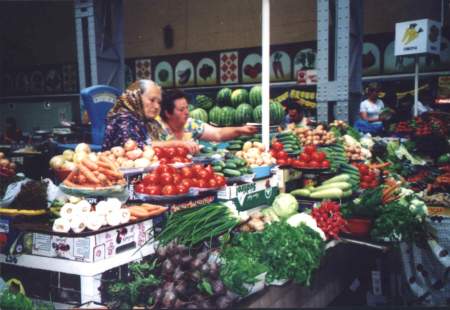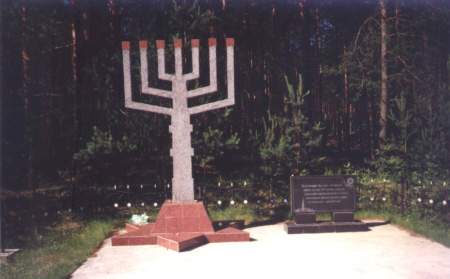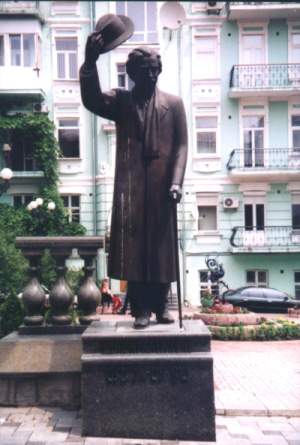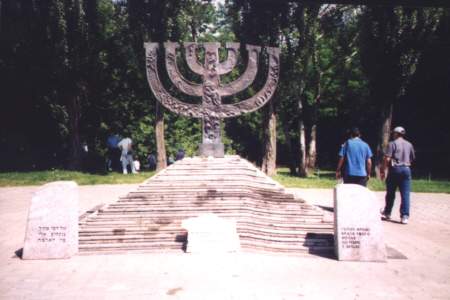A Journey to the Past - Volhynia - June 2002
By Gilda and Bob Kurtzman
Related to: Volhynia (Province),
Kiev -- Rovne -- Kusmin -- Slavuta -- Staraconstantinova -- Nicolayev -- Uman
Gilda and Bob Kurtzman" gildak@zahav.net.il
On June 17, 2002, an organized group of Israelis set out for a visit to Vohlynia in Ukraine. Most of our group of 19 people, (which includes the Israeli guide) were survivors of the Holocaust. Bob and one woman were children of people who had lived in Ukraine but had left Ukraine earlier. The Israeli guide’s parents were survivors.Vohlynia, Ukraine is both beautiful and ugly. The two major towns we visited were Kiev (the only city to which El Al flies) and Rovne. Kiev is a composition of older style architecture mixed together with the typical Soviet style block buildings. Rovne is just ugly and dirty. There is no awareness of tourism and the hotel rooms were not of the standards to which we are accustomed. The hotel in Kiev had a luxurious lobby but the rooms we were given, as a group, would be rated here as two-star. I would rate the hotel room in Rovne as minus-one star. The sheets and towels were clean. The bathtub was stained, the plumbing old, and there was no hot water after 10 p.m. until 6.30 a.m.
 |
|
But the countryside is magnificent. There are miles and miles of rolling green expanses, large and lush forests, and many farms with large plots of all kinds of vegetables and grains. Hiding in the thick forests is what saved many of the few Jews who managed to escape the horrors of the Holocaust.The collective farms were the property of the Soviet regime until Ukraine’s independence ten years ago. Now they are leased to individuals and the land has not yet been privatized. Much of the equipment was stolen so the farmers work manually with primitive methods because there is no credit system with which to purchase new equipment. There is a movement to privatize in a few years by which all members of the community will get equal shares – and which, most likely, many of the shares will be sold to big conglomerates. In the meantime, the people are poor and their sustenance comes from what they grow. So, one sees in their yards, the cattle for milk products, chickens, geese, turkeys and even pigs, which will be a dinner for them in the future.
Day 1 – June 17
Arrival in Kiev late at night. We went straight to our rooms.
Day 2 – June 18
We began the day by leaving Kiev on our way to Rovne. Kiev is the capital city of Ukraine, with a population of 350,000 plus another 100,000 in the suburbs. Today there are about 12,000 Jews in Kiev. It is the most modern city and the greenest in Europe with many beautiful parks. But, the people are poor and the average monthly income is $100. In the villages people earn about 55 grivna and live mostly from what they grow.Our first stop was Zhitomer which has a Jewish population of 1,500. We visited the Chabad (Lubavitch) synagogue that was built at the beginning of the century. Only in the recent past was it taken over by the Lubavitch movement. We also stopped at a house where Chaim Nachman Bialik (the prominent Hebrew writer) once lived but it was completely remodeled and only a plaque hangs on the wall to commemorate the fact.We arrived in Rovne in the afternoon.
Rovne is a large town in Vohlynia. We visited the paltry remains of the Jewish cemetery, now a public park. About three stones are standing, only one of which was still readable. Others were used for paving the path. From there we went to the old Jewish area and saw the outside of the present synagogue plus an older one, which is now a sports center and music conservatory. In the evening there was a short discussion of anti-Semitism, given by the guide that Bob and I hired privately and afterwards someone from the Rovne Jewish community spoke but we went to discuss some things with our private guide.
A few months ago we retained the services of a researcher in Ukraine by the name of Alexander Dunai. He had come highly recommended by Sallyann Amdur Sack, the editor of Avotaynu (the International Journal of Jewish Genealogy). Alex is also a tour guide. This trip was privately organized by a group of people who were going to one specific area in Vohlynia. Since Bob’s family came from Vohlynia but in a totally opposite direction from this area which is where their families originated or, about 250 kilometers away, we decided break away from the group and tour on our own with Alex as our guide for two days. Although not Jewish, Alex is probably the foremost authority on Jewish genealogy in Ukraine. He received a BA degree in history and at some point someone asked him to do some research on a Jewish family which stirred his interest in this field. He is a charming man, highly cultured and extremely knowledgeable. We enjoyed his company very much.
Day 3 – June 19
We started our tour south to the towns of Kusmin where Bob’s father was born and raised and to Nicholeyev (Mickoleyev in Russian), the hometown of Bob’s mother. Our first stop on the way was at a roadside memorial to the Jews of Slavuta, just outside that town. It is in the shape of a menorah and the inscription reads “Here in this forest, Lysa Hill, in six graves [mass graves] are buried the remnants of 800 peaceful citizens of Jewish nationality of the town of Slavuta who were murdered by the German Fascist invaders in July 1941.” This monument was erected jointly by the Ukrainian government and the survivors of Slavuta.
 |
Monument to the Jews in Slavuta
|
Our next stop was at Staraconstantinova, where we had been told there was an exhibition of Jewish items in the museum. When we arrived at the museum, we were told that these things had been put away but a worker who had done some indexing of the Jewish families from the town insisted on going with us to the Jewish cemetery. There are a few older graves and many new ones from after the war. Regina, the lady who accompanied us told us that friends of the family tend the graves and when she saw one of someone she had known, she began to pull out the weeds around it. There is also a mass grave, a long, long row of a small heap of dirt surrounded by a white fence. At the end of the fence is a monument to the 5,000 Jews buried in the grave. This was also erected by the city together with the survivors.
At one time there were 20,000 Jews in the Staraconstantinova County with five Jewish schools. At present there is a community of 100 in the town. Bob said a prayer at the gravesite and I had tears in my eyes. The lovely Ukrainian lady, who was sighing the entire time, put some flowers on the monument. Although we had been told to bring new dollar bills to give to the people in appreciation for their generosity, she refused to take the tip we wanted to give her.Our last stop that day was at Kusmin. This was very exciting for both of us, but naturally more so for Bob.
When we entered the town we found a young woman with a child who took us to an old lady. The young woman said her mother had told her that Jews lived in the town before the war; in the center because they were mainly merchants. Unfortunately, the old lady has lost her memory and did not remember anything. However, she did not refuse our gift. The young woman did refuse to take anything although Alex told her to accept it to buy something for the child. From there we went to the Town Hall. The mayor was ill but the bookkeeper, who is 64, received us and told us a little more about the Jews of the town. She remembered they had been marched out of town, to a spot about one kilometer away and been shot. Kusmin was at least half, if not more, Jewish before the war. There are no Jews left there today and the total population of the village is 1,200.
Then she showed us a book, in Ukrainian, of the history of the village. She asked us to pay her for it, which was less than $4.00. Alex was kind enough to translate the explanations of the photos in the book plus some of the statistics. We will have to find someone who reads Ukrainian to translate the rest of the book. I doubt that is going to be possible. Nevertheless, we were delighted to get it, if only for the photographs.
Then we went to the lake, Lake Sluch. This was another high spot of the day. Bob had heard so much about it from his father and his aunt, Bessie, who used to make fishing nets for the fishermen. He had pictured it as a small river but it is a very large expanse of water, which borders on three sides of the town. The last place we visited in Kusmin was the former cemetery. Today it is a grassy hill with no evidence of any burials. There is a small mound at the bottom of the hill with trees growing on it. This is the place of the mass grave of the Jews of Kusmin. This night was spent in a lovely hotel in Krasilov, which is close to both Kusmin and Nicolayev. There are hotels in Ukraine that are comfortable with modern amenities!!!
Day 4 – June 20
This day was devoted to Nicolayev. From the moment we entered the village I was enchanted. I had the impression that Nicoleyev has not changed much in 100 years. One can get the feeling of how our ancestors lived before they immigrated to the United States. The horse and cart are still being used as transport, although there are cars and the animals are moving freely in the streets. Today’s population is 500 souls but before the war it was 1,500, half of whom were Jewish.
We began by asking a lady where the older people in the village lived and she directed us to the home of a 94 year-old man. We asked him if he remembered a number of names but the only name that he said sounded familiar was Kurtzman. He then let us come into his home and I could envision what a house looked like at the turn of the century even thought this particular home was built in the 30s. It was small; the rather primitive kitchen was immediately in front of us. To the right side as we entered was a ladder which led up to a loft in which corn was being dried. He told us that Jews owned the two houses next to his. They are now abandoned.
Across from these homes an older lady came out to speak to us. She remembers the tannery (Bob’s grandfather was a tanner) and that one Jew, who was the manager of the tannery, was saved by a family in the town. (The tannery no longer exists.) Afterwards he became the mayor of the town and even though he could not save the synagogue from destruction, he was able to save the church. The women seemed to be appreciative of this fact and she also remembered having Jewish neighbors with whom she was very friendly.
From there we went to the Town Hall where the mayor received us. Although a newcomer to the town, he was able to give us some information. The current pharmacy and school (80 children) stand where there were Jewish homes. We asked the fate of the Jews in this town and, like the stories we had been hearing everywhere, they were marched to Proskerov where they were shot at the Gunpowder Storages. The Nazis did not take the Jews to concentration camps in Ukraine. They killed them in their own hometowns.
Perhaps I am wrong but from the lack of animosity and even willingness to help us, I felt that the Ukrainians were more or less passive when it came to the extermination of the Jews, although some of the survivors said they did cooperate. Perhaps there was a different reaction in larger towns where there was not as much interaction between the Christians and the Jews and the smaller villages where they lived together in harmony. What Alex told us was that they did think the Nazis were going to liberate them from the hated Soviet rule, so the Ukrainians did not actively stop them.Our last stop for the day was at the Jewish cemetery in Nicolayev.
We drove to the site and I was sure that we had been given the wrong instructions, although Alex kept saying that it had to be there since the Jewish cemetery was always next to the Christian one. Alex started to fight his way through the grove of trees, with heavy brush, nearly waist high at times. He went further and further into the grove until we could no longer see him. We heard his voice calling us and then we started to try to make our way through. Alex was standing at one grave. When we began to read the tombstone, it was for Nechama, daughter of Yehuda the Levi. This was a find! Bob’s grandfather was Edel. Edel is the Jewish name for Yehuda. Bob’s grandfather was a levi (The levis were the priest’s assistants in the Temple in Jerusalem.). Although we know that Bob’s mother had no sister by the name of Nechama, this could have been a cousin (i.e., two first cousins could have been named for a common ancestor by the name of Yehuda (Edel).
There were three other tombstones in this cemetery. Perhaps there are more but the trees and brush were too thick to even attempt to try to find them. We then wended our way back to Rovne. In the evening about half of our group went to an outdoor coffeehouse where Bob and I drank Coca-Cola and just talked. Then a group of people came in and began singing Ukrainian songs. We then decided to sing Israeli songs. First they would sing, then we sang. It was a nice way to end a wonderful day.
Day 5 – June 21
I feel that this day was wasted. We spent an hour in the museum of Rovne, which has some artifacts from the war plus one small showcase of Jewish items. Then we drove for three hours to the grave of the Baal Shem Tov (the founder of Hassidism) in Medzhibozh. I thought it very commercialized. The grave itself is plastered over with a tremendous white box and there are charity boxes all around. There is a dining room there in which we ate a lunch of potato soup with small pieces of potatoes in it followed by French-fried potatoes. Then we traveled again for another three hours to Kiev where we spent Shabbat. We went to the Chabad synagogue for services and then had a nice dinner in the synagogue.
Day 6 – June 22
We went to the synagogue for morning services and then lunch in the same place. The synagogue Shalom Aleichem. Although there are some nice stores and a beautiful monument to Liberty with wonderful fountains around it, the city did not appeal to me.
 |
Statue of Sholom Alechem, author |
Day 7 – June 23
The morning was spent with a short bus trip around the city of Kiev (founded in the 5th century) that included stops at two beautiful churches (some people did not enter) and ended at Babi Yar. I am at a loss to describe the site. Babi Yar is a forest in which there are two separate monuments to the victims of the Holocaust.
The first one is the general memorial, with steps leading up to a statue of people falling into the ravine as they are being shot. This is for the general population (e.g., Ukrainians, gypsies, etc.) who were exterminated by the Nazis). Although there is no mention of the Jews there is a plaque in Yiddish.
 |
Monument at Babi Yar |
The second, smaller memorial is in the shape of a menorah with about ten steps that lead up to it. We said some prayers there and then heard how the Jews were stripped of their clothing, lined up in groups of 30 with their faces to the ravine, and shot so their bodies would fall into the deep ravine. If the first shot did not kill them, they would be shot at again while lying in the ravine. Afterwards their bodies were burned. When the Germans realized that this was going to be discovered, they covered up the remains with dirt. Today natural vegetation covers the pit. Thirty-three thousand Jews were exterminated there between September 20-30, 1941. Afterwards, others that were found were added.
From there we ate a late lunch at the synagogue and went to our hotel to rest up for the evening activity.
This evening, at 7 p.m. we went to the Kiev ballet. This was another high spot of the trip. The ballet was “The Corsair”. The dancers were wonderful, the costumes outstanding, and the music by Delibes beautiful. We all enjoyed it tremendously.
Day 8 – June 24
On this day we traveled to Uman, the site of the grave of Rabbi Nachman from Breslov, the founder of a hassidic dynasty whose philosophy is based on joy. The Breslov hassidim have erected a complex consisting of a synagogue around the tomb, a dining room, a mikveh (ritual bath), a hotel for the hassidim who come to pray at the tomb of their leader and even an apartment building for those who want to spend their vacations in this village. Prayers were said, the Torah was taken out and read, and then the men danced around the synagogue. I found it all quite unusual and interesting.
From there we went to a large park but did not have much time to walk around. We ate our picnic lunch there and returned to Kiev for dinner in the synagogue and then to the airport for our return home to Israel.
During the entire trip we heard stories of how these people managed to survive. It was not easy. We can by no means describe this as a pleasure trip or vacation. It was a journey – a journey to the past, with some of the joys but more of the pain. One lady found the house of her aunt, with some of the furniture still in it. Another man visited the people who helped save him. Others were disappointed by not finding their homes and wished they had more time to wander around the towns.
Only Bob and I were with a private guide for two days and another woman had a private guide for an afternoon. Many of the people would like to go back and investigate further. I have no desire to return to Ukraine but perhaps Bob will take his sons one day. For them it would be a ray of light on the curtain of the past.